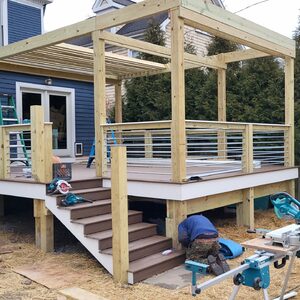I use logs for posts on houses quite a bit. Any special techniques for cutting the ends square? Also, what is your preferred way to seal the ends to a) slow drying when newly cut and b) preserve them from rot over the long term?
This cabin is only twelve years old and I am having to replace the post shown. It sits on a sono tube 3″ off the entry slab and the bottom is completely rotten. It is Hemlock and the replacement is Cedar. I’d like to get a few more years out of it this time.
https://images.finehomebuilding.com/app/uploads/2019/01/26001621/cabins_jay-otter.jpg


















Replies
I can't see a log in that photo. is it the right one?
The corner post?
I cut as close to square as I can manage, then use my 7" grinder to get it right with a couple tries.
To seal the end, use epoxy
Welcome to the
Taunton University of Knowledge FHB Campus at Breaktime.
where ...
Excellence is its own reward!
Yes the corner post is a 12" dia log.
Epoxy right away or when dry?
Need to let it cure.You can get diffeernt cure rates. Anywhere from five minutes to 24 hours.
Welcome to the Taunton University of Knowledge FHB Campus at Breaktime. where ... Excellence is its own reward!
Epoxy on the bottom of the post will make it rot faster. If this was a pile cap and the epoxy was on top, then it would work fine,the epoxy will shed the water. What happens is any moisture gets trapped behind the epoxy ,then it can't get out at the bottom.This is similar to rot in fiberglass hulls where the glass and epoxy are over plywood such as transoms.
mike
I might buy that.But how do you keep a post from wicking rain water up from concrete under it?
Welcome to the Taunton University of Knowledge FHB Campus at Breaktime. where ... Excellence is its own reward!
I've used the cast alum. square post feet with great sucess.Spheramid Enterprises Architectural Woodworks
Repairs, Remodeling, Restorations
"If Brains was lard, you couldn't grease much of a pan"Jed Clampitt
View Image
You really can't completely keep the underside of the post dry. The cast aluminum bases keep it off the concrete. Best thing that I am familiar with besides the cast bases is to use a post that will last. Depending on what's available. I would use black locust, out west probably redwood.Cedar, white oak and a few others should last .
I didn't mention pressure treated because it would not go with the original posters home.I built a fence with black locust posts about 47 years ago for an aunt. She is passed on but the posts are still there.My cousins said the picket fence itself was replaced a number of times,the posts were not.I think I used pine pickets for the original pickets.
mike
If your post is in direct contact with the concrete, it will rot. You can use a homemade pipe fitters "square" to mark for the cut. Take something like a length of 6" sheet metal that will wrap around the log a time and a half, keep the edges lined up and nice and flat to the surface.
Beat it to fit / Paint it to match
check out http://www.loghomestore.com they have borate products that help prevent rot. if you could raise the base of the post further from the ground would also be helpful. the drier the wood the less rot issues.
Use locust next time. it may out last you!
"When the spirits are low, when the day appears dark, when work becomes monotonous, when hope hardly seems worth having, just mount a bicycle and go out for a spin down the road, without thought on anything but the ride you are taking." — Sherlock Holmes, 1896
I didn't even know Locust was a tree. "A swarm of locust" takes on a whole new meaning. My choices are limited to what grows behind the resort that I can get at with a chainsaw. Generally Cedar, Hemlock or Spruce. There are a few D. Firs but I wouldn't waste them on posts.
I did separate the post from the concrete sono tube with a piece of corian. I think the trouble stems from the lack of roof overhangs, but there isn't much I can do about that.
Sorry, I forgot who I was posting to. I've been following some of your threads. Nice plase to work.
Out here in the east it is not uncommon for locust to still be used in gaurd rail posts buried and to still find it in good shape 25 yrs later or longer.
"When the spirits are low, when the day appears dark, when work becomes monotonous, when hope hardly seems worth having, just mount a bicycle and go out for a spin down the road, without thought on anything but the ride you are taking." — Sherlock Holmes, 1896
All of a sudden I'm doing nothing but dealing with logs. I just replaced all the Cedar posts in this beach house that had been buried for 40 years. after cutting them off with a chainsaw I was able to dig the bases out with my bare hands. Our climate is very unforgiving of wood.
http://farm1.static.flickr.com/137/387583350_8cdc049fd8_o.jpg
I see you're on the Island. There must be people there (log home builders?) who know the technique (but are they willing to share??).
Here's a pic of a flared-butt cedar in our house. The guys wouldn't tell me how they did it, but it was obvious that it was done freehand with a chainsaw. The bottom, sitting on 3/4" shims waiting for flooring, is perfectly square with the top holding the beam. The butt flares about 36" dia. No idea how they did it, but they made it sound like it was easy. They chuckled when I asked how they did it.
Now that I think of it, it must have been easy because I gave them a peeled log with most roots cut off. They must have done it with one or two cuts.
Sorry I can't offer much help. Good luck.
Scott.
Oops...sorry, here's the pic.
View Image
Scott.
Edited 4/26/2009 1:02 am by Scott
Ow, my toe!View Image
LOL. Hasn't been a problem so far. The kids like sliding down that one big root though....Scott.
My next thought was male dogs..LOLView Image
Hemlock is the first to go. My experience has been only alder rots faster if exposed at all.
Unfortuantely the good preservative products are all illegal now. Have some posts outside that are close to 40 YO (but are D Fir) that are sitting on concrete risers with no rot but was able to soak the end in a creosote and penta mix overnight. Still have a stash of penta that I use when absolutely needed. Also used an aluminum plate between the concrete and the post, plus sealed the open post end with roofing tar and slapping a disk of roll roofing onto the bottom before putting down onto the aluminum, sloped away from the post.
Since I still have a penta stash, no good sugestion for preservative ow(borax now or something similar per other threads?)
Did not find the bridge thread right away again, how is that determination going? A 1/4" auger should be able to gather data on that condition?
I had this book marked from that other thread-http://www.domyownpestcontrol.com/timbor-p-144.html
and another from that thread-
http://www.ewoodcare.com/Impel-Rods--12-X-2_p_0-13.html
Didn't see if your log is placed horizontally or vertically... but...if we're cutting posts that are basically round with little taper, we make a ply wood box that slips over the end, and get's shimmed squarely to the log. The box serves as a guide, and keeps chain oil from staining the log.On particularly gnarly trees, like cedars, we eyeball cut, stand them in the desirable orientation, scribe, hog off with a power planer, then go to the line with a grinder. Hollow out the center a little for a press fit.We did some vertical cedars last week, I'll try to remember the camera tomorrow.http://www.tvwsolar.com
Now I wish I could give Brother Bill his great thrill
I would set him in chains at the top of the hill
Then send out for some pillars and Cecil B. DeMille
He could die happily ever after"
Thanks. That sound like the way to go.
Here's some pics of some cedars we set yesterday. We just stood them up, propped them plumb, and scribed to the stone. Then, set them on horses, power planed the bulk, and ground to the line. We did grind a slight hollow in the bottom, which you can't really see in the pics.http://www.tvwsolar.com
Now I wish I could give Brother Bill his great thrill
I would set him in chains at the top of the hill
Then send out for some pillars and Cecil B. DeMille
He could die happily ever after"
The green tape was for witness marks to line the trees back up like we scribed them.http://www.tvwsolar.com
Now I wish I could give Brother Bill his great thrill
I would set him in chains at the top of the hill
Then send out for some pillars and Cecil B. DeMille
He could die happily ever after"
That's some nice stone work. You have a hand in that?
I cleaned up after the masons.http://www.tvwsolar.com
Now I wish I could give Brother Bill his great thrill
I would set him in chains at the top of the hill
Then send out for some pillars and Cecil B. DeMille
He could die happily ever after"
I was with you on your last post, but I'm a bit thick and lost you on this one. How do you prop them in place to scribe them before they are cut to length? Aren't they too long?
For this job, we cut a hole in the sheetrock ceiling. Rough-cut the log, stood it up, and wedged it in the hole when it looked right, and measured agreeable reveals.When we have the log back on the horses for the final cut, we take the sheetrock cutout, line it up with the witness marks we made on the tree top, scribe, cut the piece in half, and put it back in the ceiling when the tree is locked in place. Clear as mud, huh? I shoulda took a video, eh?http://www.tvwsolar.com
Now I wish I could give Brother Bill his great thrill
I would set him in chains at the top of the hill
Then send out for some pillars and Cecil B. DeMille
He could die happily ever after"
Thanks. I am just starting my annual batle against Carpenter ants here at home.
"Did not find the bridge thread right away again, how is that determination going? A 1/4" auger should be able to gather data on that condition? "
The owner won't do anything until fall when all the tourists disappear. He is more concerned with the 4"x" cross members that are quite rotten, but to replace them the decking has to come up and the railings somehow be supported or removed. He is a man of temporary enthusiasms, which can work in your favour: If you don't think something is a good idea, you just stall until he finds something else more interesting and anything else is completely forgotten.
I cut quite a few piles. If the cut is critical I'll use a 'wraparound' like Hamer1 suggested. http://www.deltaconne.nstemp.com/wizardwrapmedium.html
For end treatment we always melt hot tar on any ends exposed to the weather.
Cutting a log "square," in other words, whacking an end so that the cut plane is normal to the log's axis, is commonly done here in my neck of the woods, where logs are used in all kinds of homebuilding.
The jig and tool setup shown here was shown me by the best timberframer around, Mr. Steve Amstutz of Amstutz Woodworking.
View Image
The log is set up on horses at a convenient height. Steve uses a digital smart level, so the log does not have to be level.
A level is used at each end of the log to draw crosshairs on the end cuts, plumb and level, crossing as close to the center as is possible. Then a chalkline is snapped along both sides of the log, connecting the ends of the level crosshairs at each end.
An open ended box, made of 3/4" plywood with reinforced corners, has an array of large "set screws" that thread through nuts fixed inside wooden bosses. See the pic.
The four set screws of one end of the box are tightened to the log so that the top of the box is level across its width. Then the other four are loosely set against the log.
The smart level is laid along the log to measure the angle of the side chalkline. Press the button for memory to lock in the angle, then use the level on the box, adjusting those second set of screws until the angle for the box along its top length, matches the log line.
The pic shows the bar of a chainsaw, to which is bolted large UHMW plastic discs, set out with spacers. Those discs ride against the end of the box to make the cut.
View Image
"A stripe is just as real as a dadgummed flower."
Gene Davis 1920-1985
That's a nice setup - and illustration. A bit more sophisticated than me standing in the rain hacking away by eye with my Stil.
The plywood mill near here used to sell "peelers" that were almost perfectly cylindrical. They were much easier to cut than the more naturally shaped logs I have been playing with recently.
As an aside: I have been meaning to mention how much I enjoy the 3D modelling you do to explore various themes that catch your interest.